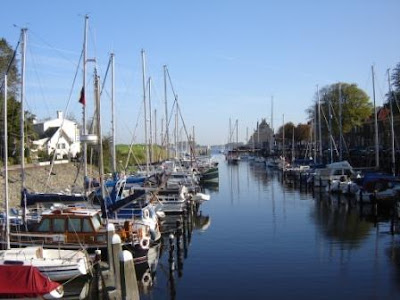We left just after supper on Friday. The drive down took about two hours, most of it on the country's expansaive array of expressways. The highways were nice, but I wouldn't want to be on them during rush hour; for eight at night, they were pretty darn full.
View Larger Map
I never get tired of illustrating the size difference between Canada and The Netherlands. The drive there, about 150 km, represents driving across about 40% of the country's length. A similar trip in Canada, say from Neepawa to Winnipeg, covers barely a third of the way across the province.
The first morning Thom, Job and I trekked down to the beach, which is only a ten minute walk from the cabin. (For some reason I don't have any pictures of the cabin itself, which is weird. But it's basically a house.)
Here's Thom on the swings before we left and Job in the yard, scowling for some reason.
In front of the beaches are huge sand dunes. I think these ones are natural, but many are artificial to prevent any flooding.
The only things in Holland bigger than its churches are its beaches.



Later that afternoon we headed down to Zierikzee, which is the regional center on the island we were on. (The province of Zeeland has a few big islands, a lot of which is reclaimed land--but more on that later.)
View Larger Map
Zierikzee was a beautiful, historic town. It was fairly crowded and lively.






Above is a wall that originally surrounded the city. It was sort of a gateway to the area, and below you see one of the towers built at either end of the city that served as the literal gateways. Anyone wanting to enter the city had to pay a toll.


If you look in the distance below, you'll see a large tower with a strange-looking peak on top. It's known as the "unfinished church"; it never got finished for lack of resources. So it stands as a massive relic, and one can only wonder what it would have looked like if had ever been finished, as it was planned to be twice as tall.




This is the church beside that huge tower. It looks more like it a seat of government or something.

On Sunday I went for a huge bike ride. Hans dropped me off in the town of Veere, and then I biked back to the cabin.
View Larger Map
It was a thirty kilometer trip; tiring but worthwhile. The town of Veere is a very little place, only about 1000 people, but a beautiful harbour area.




And, as is constituitionally required* of any Dutch town, it has a church that is MUCH too big for the rest of it.
*not really


Around the edge of the town were big fortress walls, heralding back to a time when towns were constantly in danger of being overrun by rival armies.


Amazingly, the door leading into the walls was open. I'd seen many of these doors but they were always closed and locked. I peered inside, and saw a long, dark, descending corridor.
I very badly wanted to walk inside and explore, but I had a paranoia that the door would close behind me (either by a person or a ghost), and I figured that it would be a pretty bad place to get trapped. I stayed out.
Later on I came to a huge dike with many people on top. The wind doesn't just get used for windmills around here!

Nearby was an even bigger beach than the one by our house.

Below is a huge dam built about 50 years ago. You can see a bunch of gates which are used to control the amount of water let through. A road is built across the top of it.
In the 1950s there was a catastrophic flood in the area that killed over 1800 people. Over the next fifty years a massive waterworks project was launched called the Delta Works, and as a result almost all of the waterways in the area are controlled and hedged by manmade structures.
Sometime I am going to write a post on the water management and dam building projects The Netherlands has undertaken, necessary both for reclaiming land and to protect the large amounts of the country that are below sea level. The Dutch are seen as the world leaders in water management (Dutch teams were the ones who built the manmade island for Hong Kong airport, for example), and the dams built around Holland are seen as engineering marvels.
Below is the castle at Burgh-Haamstede, a town on the way back to the cabin. The castle was behind a fence and locked gate, so I couldn't get too close.


I did something on Tuesday, but it's a mystery to be revealed in my next post. (How's that for suspense?)
On the last day I was out there Hans and I took the kids fishing with an old fishing rod they found in the garage. We fished with live worms, which was a first for me.
At first I was dubious that there were any fish in the lake but then to my surprise I started to see fish jumping out of the water...BIG fish! We never caught anything while I was there, but we did get a pretty good bite.








3 comments:
I love the photo of the youngest boy running down to the beach! But what were you doing with the tools?
Funny that you notice that...it's already become the background on my desktop, as it's one of my favourites too.
As for the tools, we were building a sand castle, of course.
Of course. I always just did it the old fashioned way, with my hands. It must have been a pretty good one.
Great minds think alike Brian, you should know that.
Post a Comment